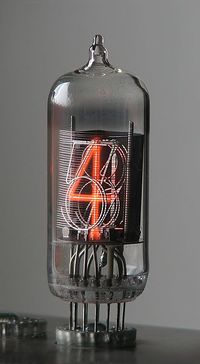Nixie tube

In electro-mechanics, the Nixie tube is a technologically-advanced multi-moded vacuum tube, capable of storing and displaying a whopping four (4) bits of computationalized information. Initially constructed in 1940 using surplus stone knives and bearskins, the Nixie tube has long since become one of the fundamental cornerstones of today's ultramodern world of tomorrow.
Primary historical precursor of the Nixie tube[edit | edit source]
The primary historical precursor of the Nixie tube was a steam-powered device colloquially known as the Steam-O-Lux™, which utilized large puffs of scalding-hot water vapor to transmit data in the visual channel. Steam-O-Luxes were quite popular and widely exploited during the Age of Steam, sometimes for automated skywriting, but mostly to scare street urchins or other vermin away from critically-acclaimed saloons and/or taverns. Unfortunately, what with the growing number of nth-degree burns suffered by many inexperienced child laborers, a new technological breakthrough was needed eventually.
Today's ultramodern Nixie™ tube[edit | edit source]
The inventor of today's ultramodern Nixie tube, Thomas Alva Edison Junior, took many long hot gruelling years in a long hot gruelling laboratory on the grounds of Melon Park in California to come up a new technological breakthrough. In 1940, after thousands of futile experiments with discarded LEDs and LCDs and CRTs and digital sundials and assorted narcotics, Edison Jr filed a patent for his new device and named it after his favorite lawyer, the young and upcoming Richard "M" Nixon.
Within a few decades, Silicone Valley was producing Nixie tubes by the billions in a vast variety of eye-catching colors and flavors. By 1968, many television broadcasts such as network coverage of American manned space shots and popular game-shows employed Nixie tubes by the dozens for displaying critical numerical data onscreen.
How the Nixie tube works[edit | edit source]
Each of the ten (10) display elements of the Nixie tube is lovingly hand-crafted by enslaved street urchins from a special nickel-chromium alloy which quickly rises to a temperature of 2,300 °F upon direct application of a flowing current of reversed-polarity neutrons, and cools back down to infrared within 20 seconds when switched off. The most-common font for the numerical symbol-shapes is Comic Sans MS (which remains the only known practical application of Comic Sans MS to this day). The entire structure, including a tiny ten-way magnetoelectric switch, a tiny VLSI integrated circuit, a drop of vanilla extract, and 15 miles of interconnected copper wiring, is lovingly encased in an evacuated one-fluid-ounce whiskey bottle, which can (hopefully) withstand the violent internal forces without exploding.
The Nixie tube is the only known electromechanical device that can display all known decimal digits one at a time in a pleasingly-warm reddish-orange glow. The residual heat from the 500-watt tube can be utilized to warm one's hands or toast individual bread slices. A ten-inch long bank of chained Nixie tubes is capable of displaying any prime number up to 9,999,999,967 while roasting an entire side of beef.
Applications[edit | edit source]
Nixie tubes have so many useful applications that I don't know where to begin. Individual tubes can be jammed into standard ungrounded electrical sockets by small children in order to teach them how to count to nine. They can be strung together like christmas lights so that they may be tightly secured to Christmas trees (preferentially artificial non-flammable heat-resistant child-proof Christmas trees). A set of four Nixie tubes can substitute for a digital watch, if one doesn't mind carrying a portable 20-kilogram rechargeable battery pack at all times. The infinite possibilities are endless, or something.
Availability[edit | edit source]
As of 2023, the Nixie tube industry is booming, primarily because of waves of romantic nostalgia experienced by retired engineers and unemployed technogeeks. Because they are so expensive, Nixie tubes are readily available by the thousands in many fine electronics stores, usually sitting on an inaccessible shelf in a locked storage room collecting dust for years on end. Today's primary manufacturers include electronic-industy giants IBM, Cray Supercomputers Ltd, and North Korea.

